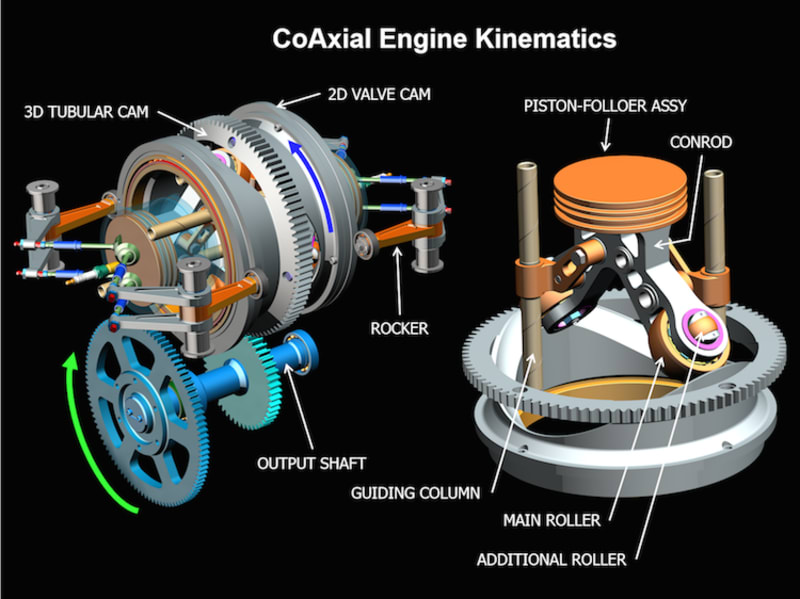

The featured design is a new engine kinematics. The mechanism that transforms the reciprocal movement of the pistons into rotation of the output shaft is a cam one.
The main components of the cam mechanism is a tubular 3D cam with a groove engraved onto interior cylindrical surface of the cam. The cross-section of the cam profile is an ark that reduces contact stresses. The 3D cam consists of two completely identical halves. In the interior of the 3D cam, two piston-follower assemblies are located. They move asynchronously so that the engine is completely balanced. The piston-follower assemblies are guided outside of the engine cylinders and thus tolerances between pistons and cylinders are generous. Each of the piston-follower assemblies consists of a V-shaped conrod. In the end of each arm of the conrods, there are a main and additional roller installed so that double and continuous contact is provided between each conrod and the corresponding cam profiles. The additional rollers are self-adjusted. To the common end of the arms of each conrod, a piston is attached. The conrods are guided by guiding columns attached to the each arm of the conrods. The 3D cam profiles could be customized in order to suit particularity of all types of fuels.
The valve-timing mechanism consists of two 2D cams that are attached to each end of the 3D cam and set into motion rockers and the adjacent exhaust/intake valves. The size of the 2D cams allows aggressive valve operation without destroying any component of the valve-timing mechanism. Thus the throttling losses during the gas-exchange phases are significantly reduced.
The output mechanism consists of two gears. One of them is intrinsic feature of the 3D cam and the mating one is attached to an output shaft. In one of the engine versions, a rotor of electrical machine is attached to the 3D cam and generates electrical power together with a stator that is attached to the engine casing. Thus a pair of electrical leads could substitute the output shaft.
The engine synergistically combines the accumulated achievements of the traditional and cam-axial ICEs. Below are some of the engine uniqueness that make it sellable product in the market:
• Novel cam kinematics – much more compact and reliable:
o two cylinders/pistons – no vibrations,
o no synchronizing gears and cam shaft for valve-timing mechanism,
o no necessarily needs a flywheel and output shaft,
• Downsized but with fewer cylinders – not smaller cylinders – low wall heat losses
• Reduced friction and simplified lubrication leading to wider ambient temperature limits of operation – most mechanical contacts are rotational.
• Superior efficiency at lower hazard emissions with less after treatment:
o low gas-exchange, friction, lubrication and wall heat losses
o flexibility in choosing of custom piston motions that allows extra time for complete combustion and multi-fuel adjustments
• Atkinson cycle effect achieved but using equal strokes – exhaust valves opening at BDC.
The featured engine is intended for light-duty, leisure and hybrid vehicles, and off-road application.
Video
-
Awards
-
 2015 Top 10 Most Popular
2015 Top 10 Most Popular -
 2015 Top 100 Entries
2015 Top 100 Entries
Like this entry?
-
About the Entrant
- Name:Boyan Bahnev
- Type of entry:individual
- Software used for this entry:NX9
- Patent status:patented








